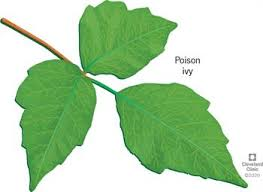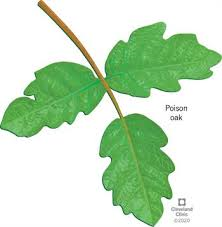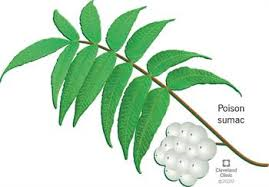The warm weather has arrived! With the warm weather comes more time spent outdoors — going for walks, hikes or staying around the house and gardening. These are opportunities where you can come into contact with poisonous plants.
Poison ivy and poison sumac are both found in Ontario. However, poison oak is not usually found in Ontario. Each of these plants contain a substance, called urushiol, which is an oily, irritating resin, that is quickly absorbed into the skin. All parts of the plants contain urushiol oil and can cause a skin reaction (allergic contact dermatitis).
Did you know?
- Even dead plants contain urushiol oil and can cause a skin reaction.
- Under hot, humid conditions the urushiol oil becomes inactive within a week.
- Under dry conditions the urushiol oil can remain harmful for a year or longer.
- No animal can develop a rash from poison ivy.
- Animal fur can hold urushiol oil and allow it pass to people and cause a skin reaction.
- Only a billionth of a gram of urushiol oil is needed to cause a rash.
- If burned, poison ivy can cause a reaction in the lungs.
___________________________________________________________________________________________________________________
What do these poisonous plants look like?
Poison ivy grows as a vine in Ontario. There are two types of vine:
- trailing vine (most common) with upright leaf stalks
- aerial vine that climbs upwards (on trees and posts)
Poison ivy can grow on sandy, or stony shores, in thickets, in clearings and along borders of woods and roadsides. Poison ivy has three pointed leaflets with smooth or toothed edges. During the spring they are reddish in colour, turn green in the summer and then various shades of yellow, orange and red in the fall. In June and July the plant has cream to yellow-green flowers and round, waxy green/yellow berries that appear by September.

Poison oak has multi-lobed leaves. The underside of the leaves are a lighter green in colour and covered in hair.

Poison sumac grows as a tall shrub or small tree in wet conditions. Each leaf has clusters of 7 to 15 leaflets that are smooth edged. During the spring the leaves are orange, turn green in the summer and are brightly coloured red and yellow in the fall. The berries are cream coloured.

___________________________________________________________________________________________________________________
What does the reaction look like?
The initial signs of exposure are redness and itching. The rash generally appears within hours after exposure, but may take up to 5 days after exposure. The rash appears where the plant has come into contact with the skin. The rash further develops into papules or blisters.
The reaction generally clears up within 7 to 15 days. A more severe reaction can take up to 30 days.
Is the rash contagious?
It is not contagious.
Itching the rash does not spread the reaction to other areas of the body. Rather continued contact with the urushiol oil, through clothing or under finger nails, will cause the reaction to appear on other areas of the body.
The blisters do not contain urushiol oil and therefore cannot cause spread of the rash.
What to do if you come into contact with one of these plants?
If you come into contact with any of these plants follow these steps. These steps may not prevent a reaction, but can prevent the reaction from spreading and may lessen the severity of the reaction.
- Remove your clothes.
- Wash all exposed areas with soap and cool water.
- Be sure to wash under fingernails.
- Alcohol (½ cup with ½ cup of water) or vinegar (2 tablespoons in 1 cup of water) can be used if soap is not available.
- Be sure not to use hot water as this will open up skin pores and allow the urushiol oil to better penetrate the skin.
- Wash all clothing and any objects (e.g.: camping gear, gardening tools, sports equipment, etc.) that came into contact with the plant.
If you think you have been in contact with one of these poisonous plants call one of our pharmacists today to discuss treatment options.
